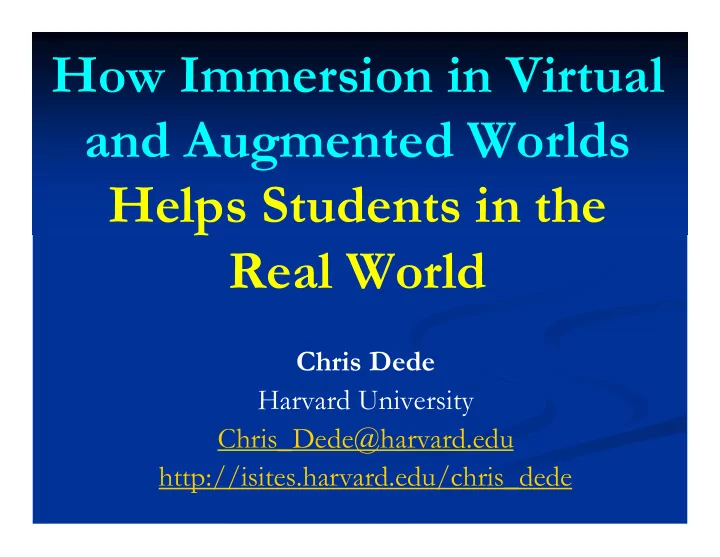

How Immersion in Virtual and Augmented Worlds Helps Students in the Real World Chris Dede Harvard University Chris_Dede@harvard.edu http://isites.harvard.edu/chris_dede
Perennial Challenges in Classrooms Classrooms are barren places without rich resources or ways to simulate the real world Students are bored compared to the many forms of engagement they have in the rest of their lives Teachers are the only way increasingly large numbers of students can get help personalized to their needs Paper and pencil, item-based assessments cannot measure deep knowledge and sophisticated skills
Situated Learning and Transfer constellations of architectural, social, organizational, and material vectors that aid in learning culturally based practices apprenticeship (the process of moving from novice to expert within a given set of practices) legitimate peripheral participation (tacit learning similar to that involved in internships) high fidelity is not important unless essential for task (e.g., interpreting photographic images)
Next Generation Interfaces for “Immersive Learning” Multi-User Virtual Environments: Immersion in virtual contexts with digital artifacts and avatar-based identities Virtual Reality Full sensory immersion via head-mounted displays or CAVES Ubiquitous Computing: Wearable wireless devices coupled to smart objects for “augmented reality” January 2009 issue of Science
EcoMUVE Funded by the Institute of Education Sciences of the U.S. Department of Education. Middle school science Ecosystems, Causal complexity. Two MUVE-based modules implemented over two weeks within a four week ecosystems curriculum. Timeline: July, 2008 - July 2011
Project Overview Ecosystems have complex causal dynamics. Even after instruction, students often retain misconceptions. In our experience, MUVEs can help students engage in authentic science inquiry and gain deeper understanding. Our goal is to develop EcoMUVE as a MUVE that, as part of a larger curriculum, will enable a richer understanding of ecosystems and complex causality.
Module 1: Pond Ecosystem Modeled after Black’s Nook Pond in Cambridge, MA
Change over Time
TI Nspire
Non-Obvious Causes
Unintentional Agency
Naturalist Microscopic Water Private Specialist Chemist Investigator Observe pond for Observe duckweed Observe pond for Talk to virtual golfer similarities to similarities to EcoMUVE EcoMUVE Observe virtual fish View 3D model of Measure dissolved Observe storm duck oxygen water pipe overlay Calculate fish Video of starch Video of how Find inlet and outlet population size decomposition by oxygen dissolves in of pond bacteria water Collect Observe virtual Measure water Talk to young girl macroinvertebrates bacteria temperature about what a watershed is ID macroinverts and Measure pH Measure phosphates Measure turbidity calculate tolerance index Work together to create video that summarizes the health of the pond based on whole team’s observations
Interaction between Biotic and Abiotic Factors Runoff causes increased phosphate levels, leading to increased plant growth. Plant decomposition by bacteria consumes oxygen, causing the eventual fish kill. http://ecomuve.gse.harvard.edu
Next Generation Interfaces for “Immersive Learning” Multi-User Virtual Environments: Immersion in virtual contexts with digital artifacts and avatar-based identities Virtual Reality Full sensory immersion via head-mounted displays or CAVES Ubiquitous Computing: Wearable wireless devices coupled to smart objects for “augmented reality” January 2009 issue of Science
1976 2012
The Evolving Mobile Experience COMPUTING ENTERTAINMENT MESSAGING VOICE
Always On, Always Connected Devices ALWAYS-ON ALL-DAY LOCATION MULTIMEDIA UNPRECEDENTED SECURITY CONNECTIVIT BATTERY LIFE AWARE PERFORMANCE POWER & SPEED Y
Beyond “Old Wine”: Augmented Reality Augmented realities utilize mobile, context-aware technologies that enable participants to interact with digital information, videos, visualiazations, and simulations embedded within a physical setting. Location-aware AR presents digital media to learners as they move through a physical area with a GPS-enabled smartphone or similar mobile device Vision-based AR presents digital media to learners after they point the camera in their mobile device at an object (e.g., QR code, 2D target).
(Conner Flynn) (Conner Flynn) EcoMUVE is going Mobile http://ecomobile.gse.harvard.edu
Does augmented reality Does augmented reality enhance learning on a field enhance learning on a field trip? trip? (Zonkio.com) (Zonkio.com)
Texas Instruments NSpires with Vernier Environmental Texas Instruments NSpires with Vernier Environmental Probes Probes
LEARNS FILTERS What Out the You Like Irrelevant SENSES KNOWS Local Content You and What is and Services Around You DISCOVERS INTERACTS Things Relevant With to You Networks Interface for Your Digital Life IN THE FUTURE YOUR MOBILE PHONE WILL ACT AS YOUR DIGITAL “6 TH SENSE”
Why Immersion for Learning? allow simulated experiences otherwise impossible to deliver. increase engagement in learning by allow students to immerse themselves in a virtual world. support new forms of interaction and collaboration enable embedded hints and tutoring delivered via situated, just-in-time processes. Increase – and assess – learner’s knowledge, skills, and self-efficacy. promote transfer to the real world more than other forms of instruction
The 2010 NETP Response to Congressional mandate for five-year plan for educational uses of technology Plan for transforming education with technology in response to urgent need to remain competitive in a global economy Reflection of increased understanding of how to support learning and of growing capabilities enabled by technology
Transformation of Formal Education
A Different Model of Pedagogy Experiences central, rather than information as pre-digested experience (for assimilation or synthesis) Knowledge is situated in a context and distributed across a community (rather than located within an individual: with vs. from) Reputation, experiences, and accomplishments as measures of quality (rather than tests, papers) 30
Core Principles of Professional Development Teachers teach as they were taught. The important issue is not technology usage, but changes in content, pedagogy, assessment, and learning outside of school. Continuous peer learning is the best strategy for long-term improvement.
Professional Development: Communities of “Unlearning” Developing fluency in using emerging interactive media Complementing presentational instruction with collaborative inquiry-based learning Unlearning almost unconscious assumptions and beliefs and values about the nature of teaching, learning, and schooling Crucial issue for professional development
Recommend
More recommend